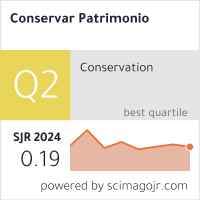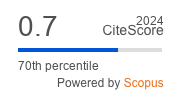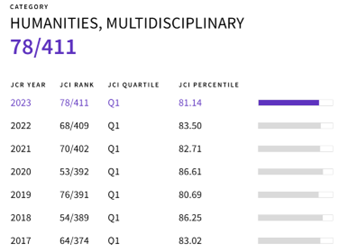O tempo do tricot: desenvolvimento de uma abordagem científica para o estudo de malhas
DOI:
https://doi.org/10.14568/cp2018034Palavras-chave:
Análise têxtil, Tricot, Gorro, Idade Moderna, Terminologia, Base de dadosResumo
O trabalho em tricot tem recebido reduzida atenção no que toca ao seu estudo como objecto têxtil, apesar da sua popularidade como trabalho artesanal. Por conseguinte, relativamente pouco tem sido publicado sobre os testemunhos antigos do tricot. O tecido de malha é frequentemente vítima de equívocos: objectos produzidos em binding needle são, por vezes, descritos como malha; outros objectos em malha continuam por ser identificados como tal. Um projecto de protocolo para a análise de tecidos, inspirado no sistema do Centre International d’Étude des Textiles Anciens, foi desenvolvido no contexto do projecto Knitting in Early Modern Europe (KEME). A necessidade de terminologia inequívoca foi identificada neste projecto como um desafio no que toca à análise académica das origens do tricot. O desenvolvimento de um protocolo e de uma terminologia e a sua aplicação no estudo de uma colecção de gorros tricotados do século XVI (disponível online) é apresentado aqui.
Recebido: 2018-7-31
Revisto: 2018-12-19
Aceite: 2019-1-15
Online: 2019-2-25
Publicação: 2019-4-30
Downloads
Referências
[1] Orton-Johnson, K., 'Knit, purl and upload: new technologies, digital mediations and the experience of leisure', Leisure Studies 33(3), (2014) 305-321, https://doi.org/10.1080/02614367.2012.723730.
[2] Malcolm-Davies, J., 'Project homepage and database', in Knitting in Early Modern Europe (KEME), https://kemeresearch.com/home (accessed 2018-7-27).
[3] Malcolm-Davies, J.; Davidson, H., '"He is of no account . if he have not a velvet or taffeta hat': a survey of 16th century knitted caps", in Aspects of the Design, Production and Use of Textiles and Clothing from the Bronze Age to the Early Modern Era, ed. K. Grömer & F. Pritchard, Archaeolingua, Budapest (2015) 223-232.
[4] Kopytoff, I., 'The cultural biography of things: commoditisation as process', in The Social Life of Things, ed. A. Appadurai, University Press Cambridge, Cambridge (1986) 64-91, https://doi.org/10.1017/CBO9780511819582.004.
[5] Botticello, J., 'The conservation of two Tudor knitted woollen flat caps', undergraduate thesis, Camberwell College, London (2003).
[6] Haase, W.; Weißgraf, T., 'Ausblühungen an Gestricken des 17. Jahrhunderts aus einer Kloake in Lüneburg', in Denkmalpflege in Lüneburg, Lüneburger Stadtarchäologie, Lüneburg (2007) 75-79.
[7] Rogers, P. W., 'Textiles', in Under the Oracle. Excavations at the Oracle Shopping Centre Site 1996-8: The Medieval and Post-Medieval Urban Development of the Kennet Floodplain in Reading, ed. B. Ford, D. Poore, R. Shaffrey & D. Wilkinson, Oxford Archaeology, Oxford (2013) 197-198.
[8] Green, E., 'Is Tudor London trendy? Tudor textiles from London: cloth, clothing and status', undergraduate thesis, Bradford University, Bradford (2001).
[9] Sagona, C., 'Two-needle knitting and cross-knit looping: Early Bronze Age pottery imprints from Anatolia and the Caucasus', Oxford Journal of Archaeology 37(3) (2018) 283-297, https://doi.org/10.1111/ojoa.12141.
[10] Hiatt, J. H., The Principles of Knitting: Methods and Techniques of Hand Knitting, Touchstone, New York (2012)
[11] Stanley, M., Knitter's Handbook: A Comprehensive Guide to the Principles and Techniques of Handknitting, David & Charles, Newton Abbot (2001).
[12] Rutt, R., A History of Hand Knitting, reprinted, Interweave Press, Loveland (1987).
[13] Black, S., Knitting: Fashion, Industry, Craft, V&A Publishing, London (2012).
[14] Buckland, K., 'The Monmouth cap', Costume 13 (1979) 23-37, https://doi.org/10.1179/cos.1979.13.1.23.
[15] Ringgaard, M., 'The knitted sugar-loaf hat', in Fashioning the Early Modern: Dress, Textiles and Innovation in Europe 1500-1800, ed. E. Welch, Pasold Research Fund & Oxford University Press, Oxford (2017) 313-316.
[16] Vocabulary of Technical Terms: Fabrics, Centre International d'Étude des Textiles Anciens, Lyon (2006).
[17] Dury, P.; Lervad, S. 'Synonymic variation in the field of textile terminology', in Textile Terminologies in the Ancient Near East and Mediterranean from the Third to the First Millenia, ed. C. Michel. & M.-L. Nosch, Oxbow Books, Oxford (2016) 1-9.
[18] ISO 4921:2000 Knitting Basic Concepts and Vocabulary, International Organization for Standardization, https://www.iso.org/obp/ui/#iso:std:iso:4921:ed-2:v1:en (accessed 2018-7-27)
[19] 19 ISO 8388:1998 Knitted Fabrics, International Organization for Standardization, https://www.iso.org/obp/ui/#iso:std:iso:8388:ed-1:v1:en (accessed 2018-7-27).
[20] Emery, I., The Primary Structure of Fabrics: An Illustrated Classification, Thames & Hudson, London (1994).
[21] Walton, P.; Eastwood, G., A Brief Guide to the Cataloguing of Archaeological Textiles, 4th ed., Textile Research Associates, York (1988).
[22] Phipps, E., Looking at Textiles: A Guide to Technical Terms, J. Getty Trust Publications, Los Angeles (2011).
[23] Thomas, M., Mary Thomas's Book of Knitting Patterns, Hodder & Stoughton, London (1943).
[24] Gilbert, R., 'The king's vest and the seaman's gansey: continuity and diversity of construction in hand-knitted bod garments in north western Europe since 1550', MPhil thesis, Textile Conservation Centre, University of Southampton, United Kingdom (2009).
[25] Malcolm-Davies, J.; Gilbert, R.; Lervad, S., 'Unravelling the confusions: Defining concepts to record archaeological and historical evidence for knitting', Archaeological Textiles Review 60 (2018) 10-24.
[26] Sun, N.; Pei-Luen, R.; Ma, L., 'Understanding lurkers in online communities', Computers in Human Behavior 38 (2014) 110-117, http://dx.doi.org/10.1016/j.chb.2014.05.022.
[27] Malcolm-Davies, J., 'Knitting virtual tribes together: new audiences for cultural objects', in Florence Heri-Tech - The Future of Heritage Science and Technologies, ed. R. Furferi, R. Giorgi, L. Governi, M. Matteini & Y. Volpe, IOP Publishing (2018), https://doi.org/10.1088/1757-899X/364/1/012031.
[28] Gilbert, R., 'Do you read my signal? An attempt at the application of clear terminology in recording archaeological knitwork', Archaeological Textiles Review 60 (2018) 25-33.
[29] Ringgaard, M., 'The church cap and the crypt cap: Early Modern knitted fragments found in Denmark', Archaeological Textiles Review 60 (2018) 34-41.
[30] O'Connell Edwards, L., 'Knitted wool stockings in the Museum of London: A study of 16th century construction', Archaeological Textiles Review 60 (2018) 42-51.
[31] Odstrilová, S., 'Early Modern stockings in museums in the Czech Republic', Archaeological Textiles Review 60 (2018) 51-63.
[32] Lundin. H., 'Knitted fragments of clothes excavated from the Swedish 17th century flagship Kronan', Archaeological Textiles Review 60 (2018) 64-74.
[33] Willemsen, A., 'Two knitted mittens from a 17th century Dutch shipwreck', Archaeological Textiles Review 60 (2018) 75-82.

Downloads
Publicado
Como Citar
Licença
O presente trabalho é distribuído nos termos da Licença Creative Commons (CC BY-NC 4.0) que permite a utilização, partilha e reprodução para fins não comerciais e sem modificações, desde que o autor e fonte original sejam citados.
O Copyright permanece com os autores.






